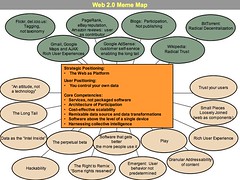John Hagel: What is Web 2.0?
(Loooong post warning...)
Well, if the Blogoposium1 is rolling, I might as well roll into it. I have some love for the topic, so here are some captured words others have written about Web 2.0 that are helping me make a little sense. A mesh-up, if you please!
John Hagel's definition hit my radar today via Elearningpost. "...Web 2.0 ultimately refers to “an emerging network-centric platform to support distributed, collaborative and cumulative creation by its users.” "
I'm paying attention. The phrase "collaborative and cumulative creation by it's users" rings a bell. Hagel goes on to describe Web 2.0 via 10 elements, all worth quoting.Platform. Platform is an important concept because it suggests a foundation that is meant to be built upon rather than self-contained.
That cumulative word. I like it. It is helping me see patterns where I only had a quiver of an instinct in terms of my work in online interaction and collaboration. Lots of good stuff here to chew on.
Emerging. It is emerging because it supports extensions to itself, facilitating a bootstrapping process to create very complex functionality from very simple building blocks. Web 2.0 is far from a finished product, it is a rapidly evolving platform.
Network-centric. In contrast to other technology platforms like PCs or mainframes, it is not a standalone platform, but instead Web 2.0 is built upon an open network, making it pervasive, extending across the entire globe. As a network-centric platform, it is device-independent – it is meant to be accessed by devices of all kinds, ranging from PCs and mobile phones to RFID tags and bio-sensor devices.
Creation. The ultimate purpose and significance of the platform is to support creation, not just communication or participation in sharing of interests. This is what makes it truly distinctive relative to previous generations of networks. We’re also not just talking about creation of media or digital products and services – this platform is becoming central to the creation of a broad range of physical products as well.
Users. Rather than viewing creation as a highly specialized activity, this platform encourages users of all types to become involved in the creation process. The well-established boundaries between producers and consumers and professionals and amateurs are rapidly eroding.
Distributed. Because it is pervasive, Web 2.0 facilitates distributed creation – it doesn’t matter where the individuals or communities reside, they can access the platform.
Collaboration. Because it is built upon a network, it also enhances the potential for collaboration. We are not talking about isolated nodes of creation, but instead the ability for individuals and communities to connect together in the creative process in ways that were never possible before.
Cumulative. Perhaps the most important aspect of this platform is that it encourages cumulative creation. This stems from the modularity that is a key design principle of Web 2.0 and it has profound implications for creative activity. It means that wherever and whenever creative activity occurs, it can be appropriated and built upon by others, further strengthening the bootstrapping process. Since what is being created is meant to be shared, it becomes less and less useful to think of the output as products and much more important to view the output as services that in turn support the creation of other services.
danah boyd wrote 2 posts (here and here) that really helped me. danah is looking at implications like...I know a lot of folks who don't want to engage because of the hype. (It's funny - business gets energized by hype; academia gets cynical.) For me, i think that everyone who cares about the next 5 years of technological innovation and techno-social culture needs to be involved and help move the big ship in a positive direction. Otherwise, it will collapse in the hands of business rather than pursuing its potential to affect people's lives for the better.
And...Web2.0 requires giving up control and ownership of information; information is meaningless to someone else if they can't repurpose it to make sense of it in their context. It is for this reason that technology is not enough - there will be political features of Web2.0 as technological development and cultural desires run head-on against legislation and political support of old skool information organizations. This is why IP and copyright issues are also critical to Web2.0.
As a person who works globally, attention to these issues is critical. CRITICAL! (yes, I am shouting)
Web2.0 also requires keeping local cultural values consciously present at all times. There is a great potential to be problematically disruptive, to destroy local culture while trying to support it. We all have a tendency to build our needs into technology but the value of Web2.0 is to allow everyone to build their needs into the technology, not just those doing the building. Trampling culture would be devastating.
Of course, there are other emerging definitions and even some images (Yay, images -- that's part of the language thing in terms of communicating ideas. More images!) I like Tim O'Reilly's because of his image.
It just dawned on me that my way of learning about Web 2.0 is VERY Web 2.0. How's that for meta!
unconference, blogoposium1

0 Comments:
Post a Comment
Links to this post:
Create a Link
<< Home